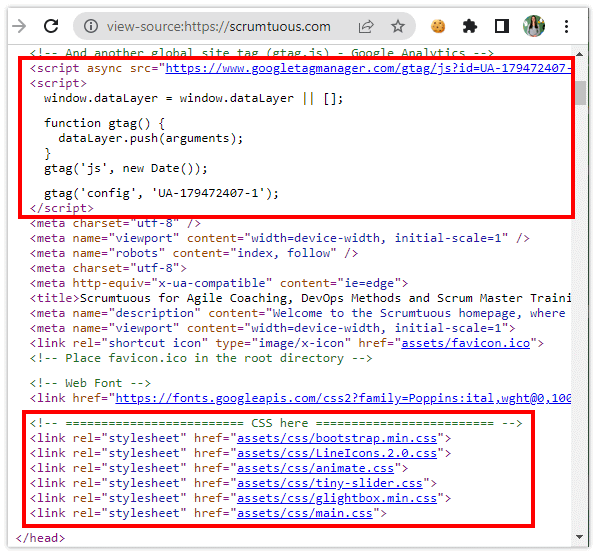How to check the technology a website is built with
Have you ever wondered how a given website was built?
- Perhaps you were keeping tabs on a competitor?
- Perhaps you wanted to build a similar site yourself?
- Perhaps you wanted to get a job at that company?
There are plenty of reasons why someone might be curious about the different technologies a website was built with.
Fortunately, for those who wonder, there are a number of fast and easy ways to find out.
Check the technology used in websites
Here are five easy ways to check the technology a website is built with:
1. Look at the URL extension
2. Use a website technology checker
3. View the webpage’s source code
4. Look at the GitHub repository
5. Do some social engineering
Look at the URL extension
The easiest giveaway to the technology a website is built with is the extension of individual webpages. For example:
- .php means a website is built with PHP: Hypertext Processor
- .jsf indicates a webpage is built with JavaServer Faces
- .do typically indicates the website technology is Apache Struts
- .asp indicates the technology used in the website is .NET based Active Server Pages
This is certainly the fastest way to identify the core technologies a website is built with. Unfortunately, it’s not as effective today as it may have been in the past.
Today, most websites will map the .asp or .jsf extension to .html, which hides the fact that their website is built with JavaServer Faces or Active Server Pages.
In the example below, you can tell by the .php extension that the website for the Texas House of Representatives was built with PHP.
The file extension used on pages can reveal the technology used to build a website.
Website technology checkers
If you don’t mind installing a Firefox or Chrome extension in your web browser, there are several popular website technology checkers you can use to find out what technology a website is built with, including:
- Wappalyzer
- WhatRuns
- BuiltWith
Brower extensions and plugins
I ran the Wappalyzer Chrome extension on my personal website and it correctly reported that my website was built with the following technologies:
- Google Analytics
- Lightbox, Isotope and Tiny Slider JavaScript libraries
- Bootstrap for responsive rendering
- The Google Font API
What platform does this website use?
The website technology checker was even able to identify that my website was hosted on GitHub Pages, and that Fastly was the Content Delivery Network I use.
Chrome plugins are an easy way to check the technologies used on websites.
View the page source
Another easy way to check the technology a website is built with is to view the source code of a webpage in the browser.
To view the raw HTML used to create a website, just right-click on any webpage and select ‘View Source’.
The source code of a web page will list all of the CSS files and JavaScript libraries used to make the page work.
A quick ‘view-source’ of my personal webpage reveals it was built with the following website technologies:
- Google Tag Manager
- Google fonts
- Bootstrap
- LineIcons
- Lightbox
Look for meta-tags
Meta-tags in the source code can also reveal the technologies used to build a website.
Meta-tags will often specify the name of a WordPress theme being used, or of the name of the vendor who created the website’s template.
The source code of a webpage will reveal JavaScript and CSS technologies used to build the website.
Explore the GitHub repository
Many websites have their contents stored in a public repository hosted on GitHub or GitLab.
This is unlikely to be true for a bank or insurance company, but many open source projects and hobbyists alike store their sourcecode in a publicly accessible repo.
If you can find a website’s GitHub repo, you can learn significantly more about how the website was built.
GitHub will even list all of the programming languages used to build the site on the landing page of the repository.
GitHub gave this breakdown of the programming languages the Twitter algorithm was built with.
Look for .gitignore files
If you do find the website’s GitHub repository, look for either a build file or the .gitignore file.
Every technology stack has their own, targeted, .gitignore file, and entries in the .gitignore file will reveal the types of technologies being used. For example:
- Python apps will have pip-log.txt or __pycache__ in their .gitignore file
- Java apps will have *.class and *.jar in their .gitignore file
- Websites built with Ruby will include *.gem in their .gitignore file
Look for build files
Build files are also a rich source of information about the libraries and frameworks that were used to build a website.
For example, a Maven POM or Gradle build file will reveal all of the different libraries a Java application uses.
A package.json file will reveal the different libraries a JavaScript app uses.
A look at the package.json file in my flashcards repository shows that my application was built with React and web-vitals, something the previously listed approaches didn’t reveal.
A GitHub repo will allow you to see the various technologies a website uses.
Social Engineering
The methods listed so far are good ways to identify the the technologies a website is built with, but they are not foolproof, and they will rarely identify backend technologies used for:
- RESTful API calls
- Database persistence
- Cloud based hosting
- Load balancing
- Middle-tier servers
One way to find out more about a company’s backend technologies is to look at want-ads they post on job boards like Monster or Indeed.
If a website is looking for developers with skills in Servlets, JSPs and Apache Tomcat development, then it’s a good bet that a Jakarta EE based stack powers their backend.
Find a disgruntled employee on LinkedIn and bribe them
— JMFT (@jftsang) March 19, 2023
LinkedIn, job boards and career pages
A look at the company’s careers page, where they list the required qualifications for job candidates can also be a good way find the technologies a company’s website is built with.
You could also look for developers on LinkedIn who work for that company and look at their skillsets. If all of the developers have a history with Spring Boot and SpringMVC, it’s a good bet that those are the technologies their website is built with.
You could even go so far as message one of the website’s developers on LinkedIn and ask them. Assuming there is no non-disclosure agreement about such things, you’ll probably find someone very interested in talking about the technologies they use everyday to build websites.







